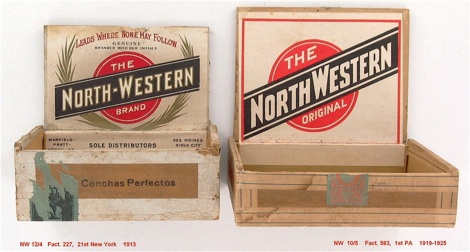Salesmen’s Sample Boxes
A Cigar History Museum Exclusive
All text and illustrations © Tony Hyman, all rights reserved.
Minor revisions: July 23, 2012

Salesmen’s Sample Boxes
A Cigar History Museum Exclusive
All text and illustrations © Tony Hyman, all rights reserved.
Minor revisions: July 23, 2012
The 1880’s saw the beginning of cigarette popularity in the United States. Cigarette makers took advantage of the invention of the small cardboard slide package to sell multiple smokes for a nickel or a dime. Sales of cigarettes in inexpensive boxes of 10 and 20 (long before cigars could be sold in small packages) forced cigarmen to find a small box to compete. The industry also needed a convenient sample package to show off the cigars, how they were banded or foiled, and what the label looked like. Giving away boxes of 25 cigars was an expensive and wasteful proposition.
Women are another very popular theme on small boxes. These all appear to have been designed speci-fically as 10s and 12s as no 25’s or 50’s of these have turned up. I find these to be a particularly appealing series of labels featuring drawings of girls.
[7792]
Boxes of 12 or 10 where the cigars were packed horizontally often used outer labels rather than cut down inner labels since they fit and were cheaper.
This box of 12 is quite rare, that size seldom being seen after WWI, the beginning of the machine age and the return to taxation based on selling price. The number of 12 boxes drops sharply after boxes of 10 were legalized in 1910.
This happy young smoker decorated cigars made by John F. Howard in Hellam, PA, in the re-opened and re-numbered Factory 1762, 1st District of PA, in the late 1920’s.
[6645]
This appears to be a genuine sample, with its back tag applied to the side of the box to show what it looked like while not interfering as much with the design of the flap.
Cigars made around 1905 in Factory 1303, 9th PA,
by J.K. Pfaltzgraff in York, PA. These cigars were also found packed in a 25/13 book shaped box.
[6635]
General Arthur was one of the country’s more heavily advertised cigars in the late 1890’s and early 1900’s. No one knows for certain who gave or sold this box to whom. All we know for certain is that it was at Christmas and that the box sports a cut down inner and flap.
The brand was originated by Wertheim & Schiffer at 407-409 E. 70th, NYC, a factory with 750 rollers which later became Kerbs, Wertheim & Schiffer, who later became part of United Cigar Mfrs. (headquartered at 54th Street & 2nd Avenue) who ultimately became part of General Cigar Corporation. These cigars were made by United Cigar somewhere around 1907. Under General Cigar (formed 1917) the brand was dropped.
[6613]
Theater and opera were popular themes in the 1840’s. The box is an unusual NW 12/12, a shape very rarely seen. Note the nudies bathing in the background. Nudity, other than in allegorical women, is not as common on cigars boxes as popularly believed.
Cigars were made in Fact. 366, 9th PA by Homer I. Garman in Denver, PA., around 1904.
[6672]
Actors have been popular on cigar boxes almost as long as there have been cigar boxes.
Lace as an inside edge trim is seen as early as the 1870’s. Lace was a special order item, requested by the wholesaler or retailer. Lace was usually part of the trim attached by the box maker but could be done at the last minute in the cigar factory.
A cropped inner was used as a label by the Putnam Cigar Co. in Patterson, NY (Fact. 481, 14th tax Dist. c.1905.
[6609] [6608]
Presentation in the box
The NEWTON is called a “NWC 12/6” by boxmakers, the “C” signifying the addition of a clasp. The cigars were made by The Hilson Co., 671 1st Ave. (Fact. 1, 3rd Dist. NYC). [6612] [6611] [6610]
Three shapes of 12’s
The most common type of sample box
The salesman’s sample shape most commonly found today is the nailed wood box of 12 cigars packed 6 across and 2 rows deep, but trimmed rather than POB. For catalog purposes, they’re “NW 12/6” but collector’s just call them “sample boxes.”
Sample boxes often weren’t samples. The small size was an immediate hit with retailers who finally had a small box of cigar that could be sold for 25¢, 50¢ or a $1.00. When these were first permitted in 1891, boxes of 10 were still 19 years away.
A JURY was a retail intended brand made by Grant Strickler of Yorkana in Fact. 2642, 9th PA around 1905. In my opinion, this is a ‘must have’ box in any collection of samples.
[5959] A Curator’s Favorite.
What the 1891 law envisioned
Since the 1700’s cigar wholesalers and retailers have used a shorthand based on fractions of 1,000. A box of 100 was a 1/10th, a box of 50 a 1/20th, and a 25 was called a
1/40th. Sample boxes of both 12s and 13s became known as “one eightieths” (1/80th), a less mathematically precise name, but everyone understood what was meant.
Cigars by M. Foster & Co. in Fact. 8, 3rd Dist. NY located at 1059 3rd Ave. [6673]
Cigar makers were not fond of samples
cigar factories’ dislike of samples:
“I have sent you by express, prepaid, several sample boxes of my 15, 10 and 25 cent cigars. You will also find matches and a cutter in the package. Should they please you, just drop us a postal and we will send you more samples. Your obliging servant,” A Satire about the abuse of samples by salesmen and retailers alike. [0610]
Everyone wanted freebies
Samples were a necessary evil to the cigar industry. Most orders include requests for samples:
[ul] “...we would like to have included eight 1/80th samples in each brand.”
[ur] “10,000 La Peruna and sets, 15 Samples.” Sets refers to matching outer labels.
[ll] “...include 4 sample boxes...”
[lr] Wing, a manufacturer, orders box maker to make sample boxes along with standard boxes.
The solution was reached in 1891 when congress authorized boxes of 12 and 13 as salesmen’s samples. This required a new size box and new stamp denominations. The box industry developed three popular configurations for sample boxes. The box pictured in the ad is the most popular of those, both easy to handle and easy to ship. It is fully described as a “trimmed nailed wood box of 12 with 6 cigars laid front to back in the top row.” Rather than write all that, box makers called it an “NW 12/6” which takes a lot less space. This box maker’s shorthand is used throughout the Museum. The ad and box are from 1905. [11051]

A wholesaler’s view of samples:
[1164]
A.T. Morris, a Cincinnati based wholesaler of “Fine Imported and Domestic Cigars” sent a 3 page letter of instructions to a new salesman setting up a territory in August of 1900. The complete letter is in the Chapter on Cigar Salesmen (click above).
Part of it was about samples:
“Sample cigars cost us more than stock goods as twice the number of boxes and labels are required and the goods themselves are all ‘selected’ which means considerable added cost. On this account, all samples we supply you in “sample boxes” will have to cost you the regular wholesale rates.
“We find our success as much the result of LARGE FINE ASSORTMENT as QUALITY and you ought to have samples of all on the list; the 10¢ goods because they not only count up fast in money, but are profitable; the cheap brands as many will want the cheapest thing you have; the Fancy Goods as they are great sellers; the high grade 5¢ goods as a necessity as they are our SPECIALTIES. As a matter of fact, you ought to have them all for it is not right to go at anything of this kind in a half-hearted manner and poorly equipped. Any store, wholesale or retail, is know more by the assortment of goods it carries than anything else and it will be the same with us there, we must carry a stock that will draw them to us. For about $14 we can give you a line of our best sellers and the balance can be added later, while for a complete line will cost you about $20. If it comes to more than that, we will make no further charge. If you order only a partial list, you better leave selection to us.
“You will always want two sample boxes of each brand you are carrying, one to keep intact for showing the appearance of the goods and the other to be using for loose sample smokers. Sample boxes contain 25 cigars so 50 of each brand is all you will need on hand for samples. You might omit one box of the 10¢ goods, but you will need two boxes of everything else you take.
“If this makes everything clear you can forward the money for your line of samples and we will got to work on your equipment. [I can furnish you with] a neat sample case for $1. My case will please you as it fits the sample boxes and I will have your name and address nicely embossed in silver, which not only adds to the first-class appearance but will render it less liable to theft.
Wholesalers were constantly getting asked for samples by salesmen wanna-be’s, so learned to charge sell them regular size boxes of 25 and 50. Once a salesman was established, smaller boxes came into play. The small boxes of 12 and 13 were what was sent to retailers and local distributors when the asked for samples.

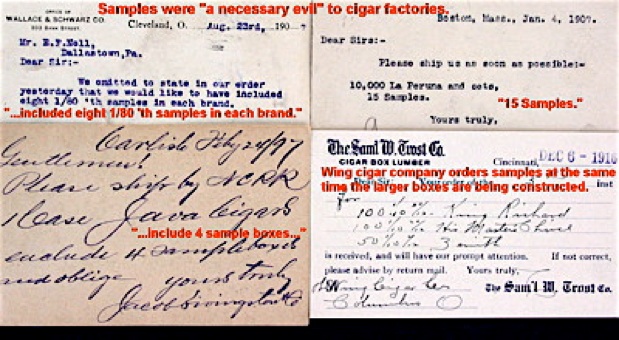
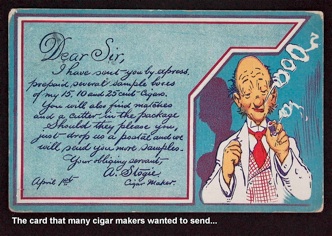
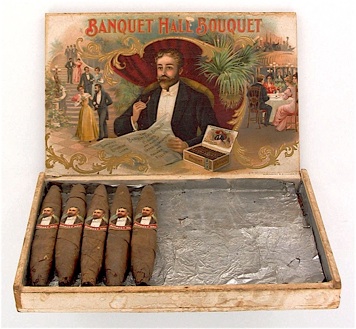

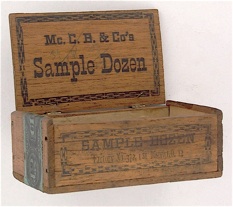
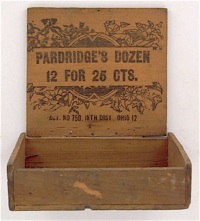
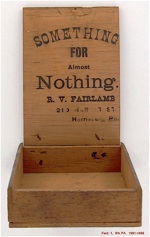
The least expensive sample boxes were “NWH 12/4h POB” or “hinged nailed wood box of 12 with 4 cigars laid the long way and all ad copy printed directly on the box.”
The 12/4h box became a popular sample but is most often found trimmed with labels.
[6633]
This 12/6h was obviously intended for retail sales rather than as a sample. This box has a taped hinge, not the standard metal hinges on most POB boxes. 25¢ was popular pricing for 12 cigars, exactly what retailers wanted.
[6634]
The 12/6v POB had two rows of 6 packed front to back. As the most common sample, written NW12/6. Fairlamb’s way to get attention? Seven different typefaces in seven lines.
[6624]
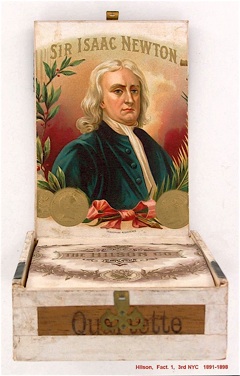

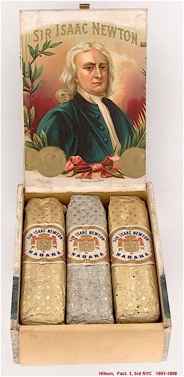

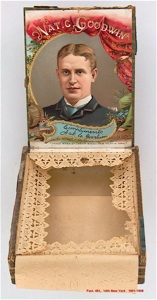
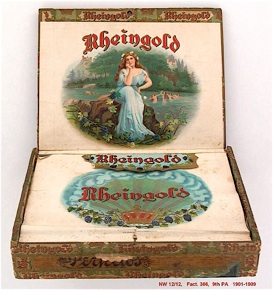
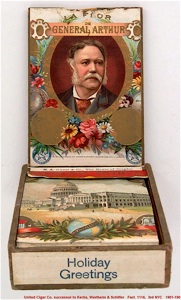
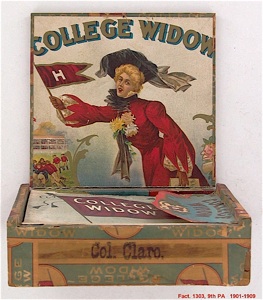
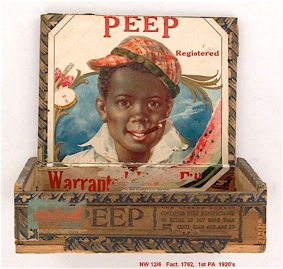



LET-ER-BURN: Fact. 828, 9th PA
Morris Hauck [?], Lebanon
A CINCH: Fact. 396, 9th PA,
JW Gohn, East Prospect
SPORTY LAD: Fact. 396, 9th PA
JW Gohn, East Prospect
THREE BEAUTIES: Fact. 1392, 9th PA Frank Meads, Windsor
A DANDY SMOKE: Fact 64, 9th PA Premier Cigar Co., Hellam

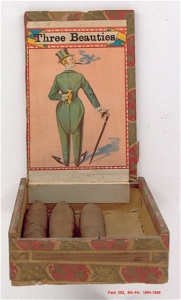
Meet more of the girls
Potpourri
Variations on a theme
GERMAN LOVERS made by Charles Soby in Fact. 387, Hartford, Connecticut
in 1908 and 1914.
[6657] [6656]
NWH 12/6 POB
expressing sentiments other than Christmas wishes are rare.
POCKET EDITION was made for Lowell by Sam Johns, Fact 295, 9th PA in McSherrystown.
O.K. cigars [not good ones?] made in the early 1890’s in Fact. 3431, 9th PA.
Out of the ordinary
Only 12 I’ve seen with a full size inner label to demonstrate what the full label would look like. Cigars by J.H. Fink, Allentown, PA in Fact. 1220, 1st PA in the early 1920’s.
SILVER STATE is the only 13/7 I’ve ever seen, and, even better, it’s from rare Fact. 2 in Colorado c1895.
Here’s an oddity you’ll probably never see again: a Nailed Wood upright dropfront 13/13 sample used to show what boxes of 100 and 250 by American Tobacco Company for their version of OLD VIRGINIA CHEROOTS looked like. Fact. 17, 2nd District of Virginia around 1905.
NOTE: most of this brand you find are marked with the name P.Lorillard from Fact. 17 VA (NOT Fact. 17, 2nd Dist. VA). These are much newer, from the 1920’s and 1930’s.
NOTE TWO: if you find this brand WITHOUT the name Lorillard or American, with an 1883 stamp, and in fine condition, please let me know.
This box not in Hyman’s NCM collection. Seen through the courtesy of Rupert Knowles.
Horizontal 12/6’s featuring women
Most cigar box women are just made-up names, but a few probably refer to real people.
Cigars by T.E. Brooks & Co. Fact. 890, 9th PA in Red Lion. [6659]
Dolly, for example, was real. She was sold in 25’s and 50’s as well as a “Pocket Edition” intended for the retail trade.
Cigars by I.N. Carvalho, Fact. 1211, 1st PA in Norristown.
[6653]
Probably a real lady fiddler, but some web searching is in order if you care. Cigars made in Detroit Fact. 318, 1st Mich. by A. Gordon, 229 Cass Ave.
[6658]
OPIA was a popular brand by Binghamton’s Barnes Smith, Fact. 1239, 21st Dist. NY. Yes, that’s an opium poppy design.
[6641]


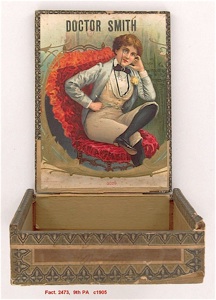
MARY N: Fact. 396. 9th PA
JW Gohn, East Prospect, PA c1912
HUSTLER: Fact. 396, 9th PA
JW Gohn, East Prospect, PA c1896
UNIQUE: Fact. 396, 9th PA
JW Gohn, East Prospect, PA c1904
DOCTOR SMITH: Fact. 2473, 9th PA
S. Heindel, Stony Brook, PA c1905
HIGH TIDE: Fact. 2028, 9th PA
JC Heckert, Stewartstown, PA c1905
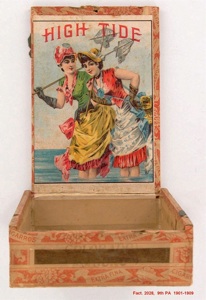


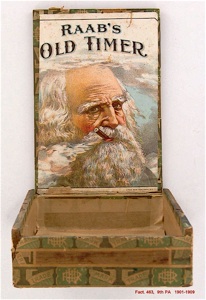

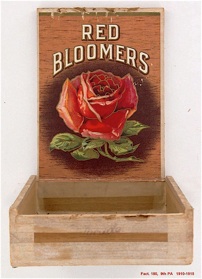

OLD TIMER: Fact. 463, 9th PA
WH Raab, Dallastown, PA c1905
TWELVE DANDIES: Fact. 857, 9th PA
Geo. W. McGuignan, Red Lion, PA
NIAGARA PEACH: Fact. 2028, 9th PA
JC Heckert, Stewartstown, PA c1905
RED BLOOMERS: Fact.180, 9th PA
Winter Cigar Co., Craley, PA c1912
VAUDEVILLE SPORTS: Fact. 200, 3rd NYC, Seidenberg & Co. c1905

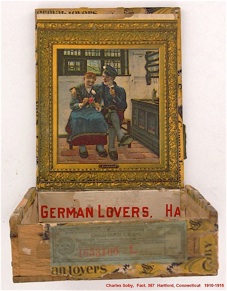
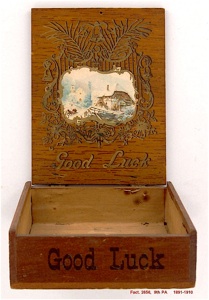


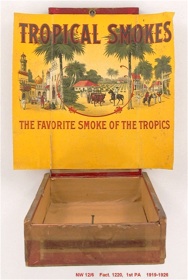
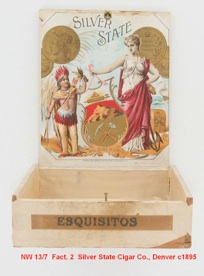
Unusual shape and, by today’s standards, unusual brand name although they were fairly popular cigars around the turn of the century. Made by Louis Heitman Co. (Fact. 701, 1st Ohio) located at
650 South Main St. in Dayton. I own an ordinary 50/13 and a nice embossed sign for the same brand.
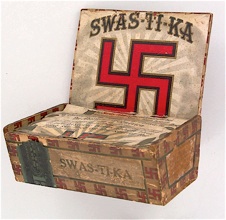

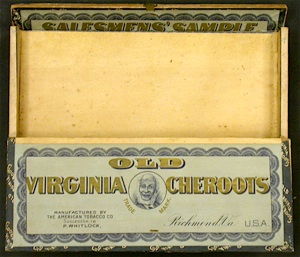
Horizontal 12/4’s, a sample
A number of labels feature cigars, scales and gold. This partly cut down outer label makes an excellent inner for cigars made in Fact. 40, 12th PA by Wirth Cigar in Canton. [6650]
Popular brand frequently seen. Made by Gus Moebs, Fact 421, 1st Mich. at 616 Hastings St. in Detroit. Odd pretty end label. [6649]
Note how “Perfectos” was set off to the side so the revenue stamp wouldn’t cover it. Box designers rarely took the stamp into consideration.
COUNSELLOR was sold nationally for decades. Cigars made in Fact. 1634, 1st PA by A.R. Cressman’s Sons in Sellersville. [6654]
This style label is found picturing other critters. Fact. 930 in 9th PA by JK Redding, Brickerville, PA. [6648]
Cigars made for Weideman Co by Thomas Kildow, Bethesda, Ohio in Fact. 12, 18th Dist. The first sample size I found, 1953. [6670]
LONDON WHIFFS was a popular cigar by Marcus Feder, 15 Middle St., Cleveland in Fact. 351, 18th Ohio. [6669]
Unique 12/4 box with a BN-like collar. Labels covering all sides is unusual, but especially so on a 12.
Cigars by La Cubana Cigar Factory owned by Yocum Brothers, Reading, PA (Fact. 103, 1st PA. [6667]
Custom brand?
It’s likely, but not certain, this was a special brand created for the hotel’s humidor. Between the Civil War and WWII every hotel had a cigar counter. Prominent hotels would maintain humidors containing cigars of frequent patrons.
The foil liner on this rare box suggests it may have been packed for the Christmas trade. Looks like a standard 12/6v box, but surprisingly has a 13 stamp.
There can be lots of reasons.
Boxes of 13 packed other than 13/13 are very rare.
Cigars made in Factory 517, 3rd District New York City by Emanuel Weigner, 502 E 73rd St.
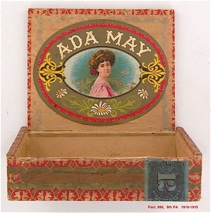
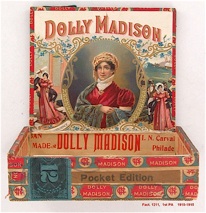
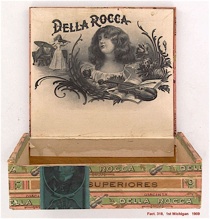
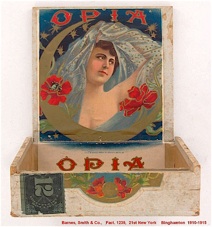
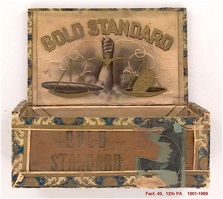
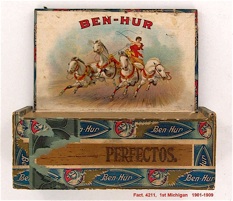



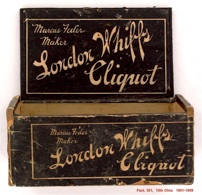

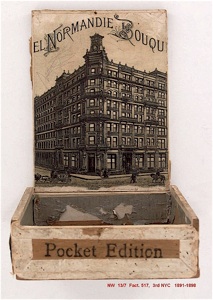
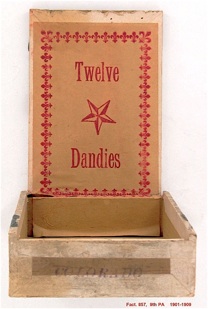
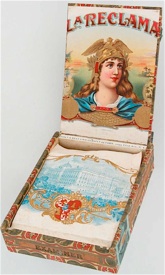
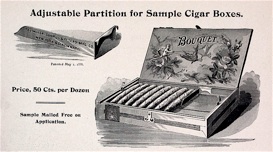
Cigar tool makers offered salesmen a sliding device to keep cigars in partly filled boxes such as this from rattling around. [4993]
A 12/4 becomes a 10/5
There is no indication these were actually sold by or on the railroad line.
[6267]
